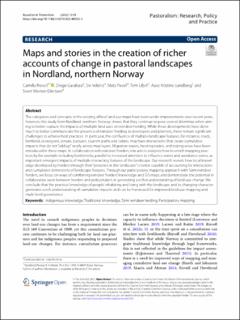| dc.description.abstract | The categories and concepts in the existing official land-use maps have been under improvements over recent years; however, this study from Nordland, northern Norway, shows that they continue to pose several dilemmas when aiming to better capture the impacts of multiple land uses on reindeer herding. While these developments have done much to better communicate the presence of reindeer herding to developers and planners, there remain significant challenges to achieve best practices. In particular, the confluence of multiple landscape features, for instance, roads, farmland, ecoregions, tenure, pastures, tourism paths and cabins, may have interactions that create cumulative impacts that do not “add up” neatly across map layers. Migration routes, herding routes, and resting areas have been introduced in these maps. In collaboration with reindeer herders, this article analyses how to enrich mapping practices by for example including bottlenecks, parallel to increased attention to influence zones and avoidance zones, as important emergent impacts of multiple interacting features of the landscape. Our research reveals how local knowledge developed by herders through their “presence in the landscape” is better capable of accounting for interactions and cumulative dimensions of landscape features. Through our participatory mapping approach with Sámi reindeer herders, we focus on ways of combining reindeer herders’ knowledge and GIS maps and demonstrate the potential in collaborative work between herders and policymakers in generating a richer understanding of land-use change. We conclude that the practical knowledge of people inhabiting and living with the landscape and its changing character generates a rich understanding of cumulative impacts and can be harnessed for improved land-use mapping and multi-level governance. | |
